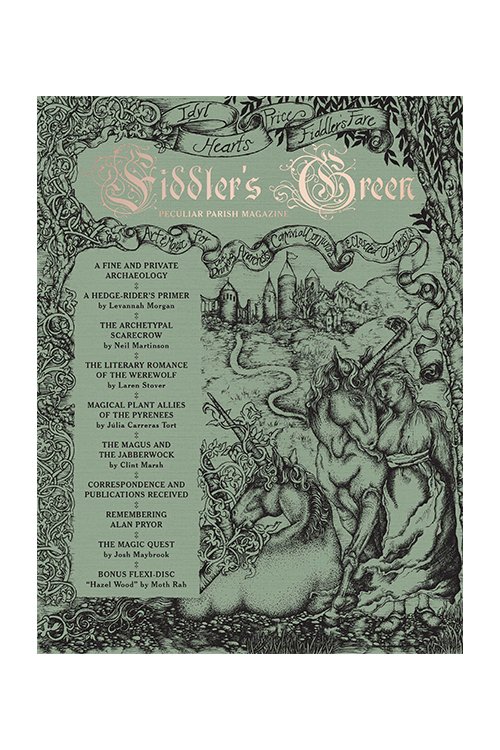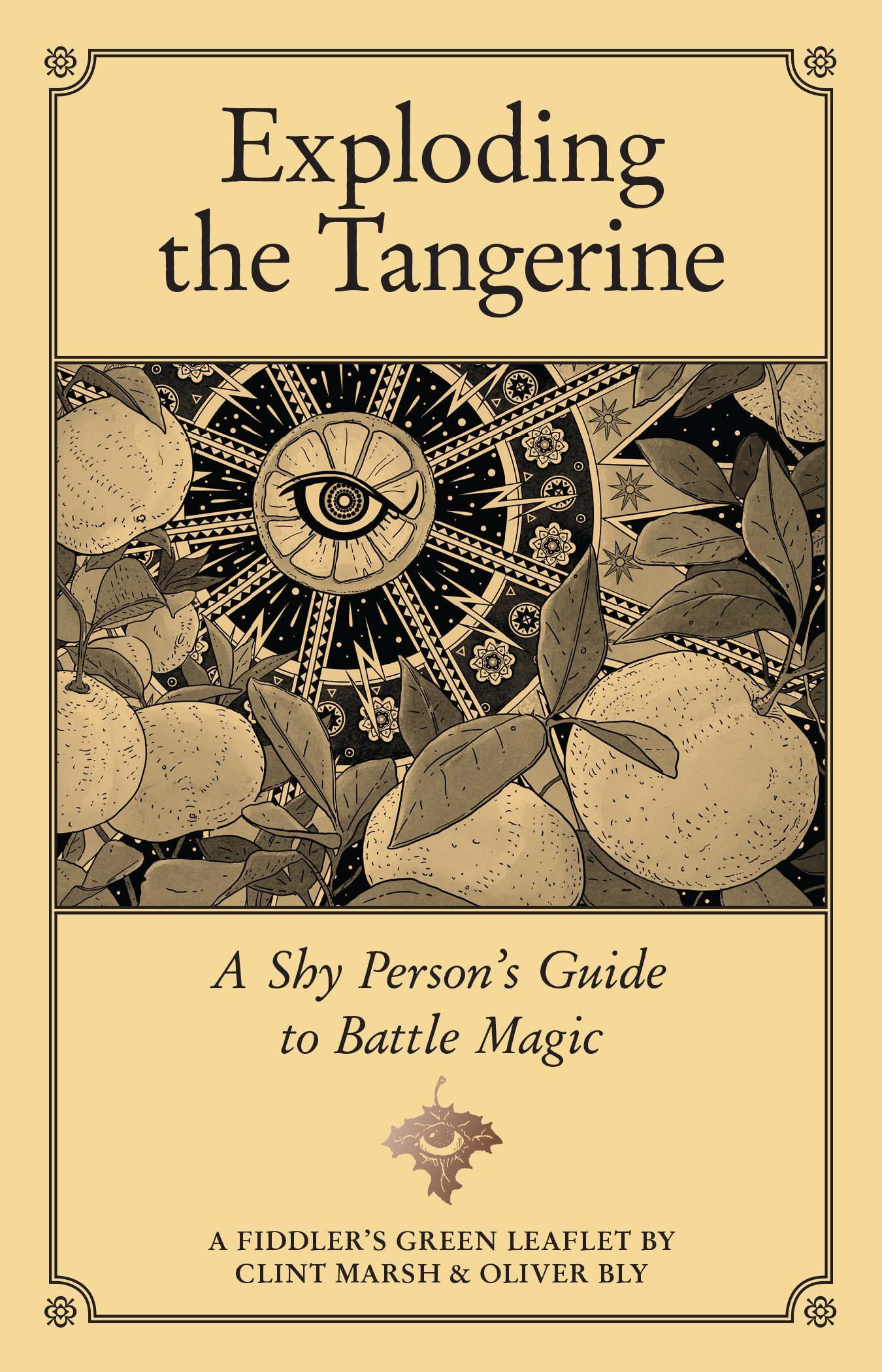Fiddler’s Green
Fiddler’s Green Peculiar Parish Magazine was born of a languid afternoon of conversation on a sunny tavern lawn. Taking its name from the pleasant afterlife dreamed into being by sailors, cavalrymen, and other adventurous spirits, Fiddler’s Green gathers friends, good cheer, and a bit of magic to create a better world not someday, but now.
In ecclesiastical terms, the word “peculiar” refers to a district outside the jurisdiction of the Church. It’s also a good word for describing my own view of reality, and likely yours as well. And so here is a “peculiar parish magazine” for anyone who doesn’t feel the need to have their inner life directed by others. If it is peculiar that we wish to govern our bodies and souls ourselves, then let us be peculiar.
The conversation continues, and there is room for you in it. Each of us is on our own journey, both in this world and whatever lies beyond it. Sometimes the path is well lit; at other times it is obscured. Your wanderings have brought you here, and I hope you’ll stray for a while with me and the other souls gathered at Fiddler’s Green.
Website - https://www.fiddlersgreenzine.com/
Fiddler’s Green Peculiar Parish Magazine
Our seventh issue, also known as “Gods of the Afternoon,” published February 2020. Fiddler’s Green 7 features copper titling, a cover drawn by Benjamin A. Vierling, and 52 pages of art and magic.
Our eighth issue, also known as “Idyl Hearts,” published November 2021. Fiddler’s Green 8 features copper titling, a cover drawn by Sigurd Persson, and 56 pages of art and magic.
Sixth issue, “Woodcutter’s Moon,” published 2 February 2019, with copper titling, a cover drawn by Matthew Glover of Sin Eater Illustration, and 52 pages of art and magic
Fifth issue, “The Otherwise,” published May 2018, with copper titling, a cover drawn by Glyn Smyth, and 48 pages of art and magic
Fourth issue, “Crown & Crossroads,” published June 2017 (1500 copies), with copper titling, a cover drawn by Timothy Renner, and 44 pages of art and magic
Third issue, “Gardener’s Giantess,” published August 2016 (500 copies), with the much-loved copper titling, French flaps, an original cover drawn by Timothy Renner [...]
Fiddler’s Green Peculiar Parish Magazine explores themes of time and landscape in this third issue.
Second issue, “Verdigris Soul,” first published September 2015 (500 copies) and reissued February 2016 (250 copies) in honor of the Occult Humanities Conference, featuring copper foil titling on the cover
Premiere issue, first published September 2014 (500 copies) and reissued February 2016 (250 copies) in honor of the Occult Humanities Conference, featuring copper foil titling on the cover.
Tales From Fiddler’s Green
Our second collection of prose and verse, with an introduction by series editor Susan Redington Bobby and a foreword from Clint Marsh. Published in December 2023 by Fiddler’s Green. Tales from Fiddler’s Green 2 features red foil titling, illustrations throughout by Niall Grant, and 80 pages of short fiction and poetry.
Our first collection of prose and verse, with an introduction by series editor Susan Redington Bobby and a foreword from Clint Marsh. Published in spring 2021 by Fiddler’s Green. Tales from Fiddler’s Green 1 features red foil titling, illustrations throughout by Open Sea Design Co., and 72 pages of short fiction and poetry
Wonderella Pamphlets & Booklets
Tomte, nisse, brownie, domovoi, drac... Beloved by children and the young at heart, the red-capped, snowy bearded gnome is known by many names around the world. While these days we see him most often at Christmas, this household spirit is in fact far, far older than our modern conception of the midwinter holiday.
Haunted by fascination, a teenage boy undertakes an ancient ritualistic working for answers to questions unfathomable by science and religion. Submitting himself to the mysteries of the magic circle, he risks spiritual sacrifice in a gamble to step into adulthood without the loss of childhood wonder.
The artist’s life presents those who dare take it up with a unique set of possibilities and challenges, among them a chance for renown long after the end of their days on earth.
As many a seasoned hiker can tell you, an incautious encounter with poison oak can turn a happy memory of a forest walk into a drawn-out ordeal of incapacitating anguish. The merest brush against the plant’s green and ruddy leaves—or even its bare stem—is apt to trigger a singular suffering perversely described by some as the pleasure.
This illustrated essay explores the profound mystery of “The Piper at the Gates of Dawn,” the central chapter of Kenneth Grahame’s masterpiece The Wind in the Willows, a beloved book bridging the worlds of animal and man.
Although the tragic love between Lady Mondegreen and the Earl Amurray existed nowhere in the pages of history or literature, it couldn’t have been more real in the mind of the young girl who dreamed the lovers into being after mishearing a verse of classic poetry. She let her imagination fill in the blanks to create a new reality, inhabiting it heart and soul.
Written in 1881, Meredith’s poem takes inspiration from Shelley’s “Ode to a Skylark” and in turn inspired Ralph Vaughan Williams’ violin masterpiece of 1921. One century on, our Peculiar Parish Edition is offered in humble commemoration of the “silver chain” of influence wrought by the best of the arts.
Your home library is more than a mere collection of fact and fantasy. By acquiring and keeping each of the books that line your shelves, you craft an ever-changing self-portrait made of memories, knowledge, hopes, and secrets unique to you alone.
In antiquity the wild places of the world were menaced by the dreaded “king of all reptiles,” the basilisk, a creature so vile that it could turn brave heroes to stone with a mere look. Today we face the basilisk every time we are gripped with anxiety so strong it stops us in our tracks.
Magical duels are depicted in film and other popular fiction as flashy affairs full of supernatural fireworks, and they’re often given as proof of a person’s ability to use “real magic” for self-defense and to influence the world around them.
Have you ever crossed your fingers or wore a special piece of clothing, telling yourself you’ll be luckier because of it? We all engage in superstitious behavior to some extent, even if we’re not sure whether it works.
Robert Louis Stevenson’s “Christmas at Sea” was first published in the 22 December 1888 edition of The Scots Observer, in the poet’s hometown of Edinburgh. Two years later it was selected as the closing work in Stevenson’s Ballads.
Mystics and intellectuals have extolled the virtues of stimulants throughout all of human history, believing that the use of certain substances can bring them closer to the ineffable. Although arduous journeys along “the poison path” appeal to many psychonauts, there is also much magic to be found in the use of milder stimulants.
Even before his birth, the life of Oscar Wilde was one shaped by dark, otherworldly forces. From a childhood spent in the fabled lands of Tír na nÓg to his star-crossed romance with Lord Alfred Douglas, Wilde’s trajectory through the artistic and social worlds of his day seemed guided by strange fate, some of it prophesied in his most famous works, including Salomé and The Picture of Dorian Gray.
























